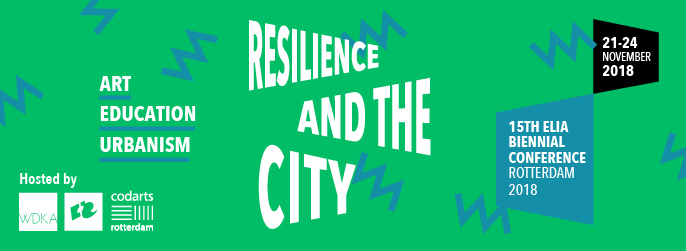15th ELIA Biennial Conference
Resilience and the City: Art, Education, Urbanism
Rotterdam, the Netherlands
21-24 November 2018
“Over the past decades, few concepts have gained such prominence as resilience. Resilience is the capacity of a system, be it an individual, a forest, a city or an economy, to deal with change and continue to develop. It is about how humans and nature can use shocks and disturbances (like a financial crisis or climate change) to spur renewal and innovative thinking”. (Stockholm Resilience Centre)
In 2018 the 15th Biennial Conference of ELIA brings together two leading Dutch academies at the forefront of art education, It is an opportunity to showcase the two nationally and internationally renowned programs that promote excellence and talent in the visual and performing arts. Significantly, it is also an opportunity to profile the city of Rotterdam, which was recently named by the New York Times as one of the top ten cities to see.
The 15th ELIA Biennial Conference sets out to examine how the arts can play a vital role in building resilience, especially in the urban context. The topic will be developed along four subthemes:
Shifting Centres, Shifting Margins
The world is always changing. But changes are becoming greater and more rapid than ever before, due to unprecedented technological advancement and unpredictable political upheaval. Margins and centres are continually shifting. From expanding urbanisation to immigration to climate change, we are facing grand societal challenges that require radical questions and innovative answers.
The City of Rotterdam is addressing these challenges by becoming a ‘resilient city’. Urban resilience is the capacity of individuals, communities, institutions, businesses and systems within a city, to survive, and adapt no matter what kind of chronic stresses and acute shocks they experience. Arts and culture are fundamental in shaping the critical discussion about urban resilience, pointing to dimensions of urban development that often too-eagerly embrace neoliberal concepts of gentrification and commercialisation, bringing changes that are profitable for some, but negative for others.
Art and Social Cohesion
The Arts enable us to express and develop our cultural identities and reveal the diversity within our society. Cross-disciplinary projects create new structures that can pinpoint social tensions, address differences and demonstrate how much we have in common. In addressing these social challenges there is also an imperative to uphold a heterogeneous society, protect minority rights and integrate or perhaps also simply accept differences of all kinds. Do the arts, especially socially engaged artistic practices, gain a particular responsibility in times of increasing right-wing conservatism, when the freedom of artistic expression is threatened?
Art and Economy
Urban resilience cannot be achieved without economic prosperity. An innovative city is one, which is sustainable environmentally, socially and economically. Fostering vibrant and proactive cultural communities, therefore, needs to be a priority for any resilient city. How do we see the interaction between the arts and economics, in what ways can artists and urban planners collaborate to create alternative cultural and social habitats, which promote common practices and different forms of living together?
Art and Innovation
In 1968, NASA developed a tool to assess creativity skills, in an effort to increase innovation by hiring the most creative engineers. The test worked so well with employees that they decided to test it on children. To their surprise, 98% of 4-5 years old were considered geniuses on the creativity-scale. When they tested the same group 5 years later, only 30% of the children scored in the genius-level of creativity. The NASA survey shows both the importance of creativity for innovation and the declining levels of creativity, as we grow older. How do we see the role of arts and arts education in improving creativity and 21st-century skills? And what is our own role as arts education institutions in addressing these changes, both for our students and for society?
ELIA Biennial
Take part in the largest conference on Higher Arts Education and join international colleagues in an engaging 3-day programme featuring high-profile speakers, plenary discussions, paper presentations, best practices, networking events, mobile sessions at cultural institutions in the city and much more. Visit ELIA site for more information.
The identity of 15th ELIA Biennial is designed by Studio Bureau.

